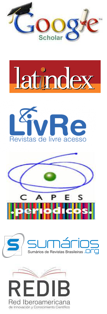Tradução Intersemiótica: o Intercâmbio de Linguagens
DOI:
https://doi.org/10.17921/2447-8733.2016v17n4p341-345Resumo
Este artigo relata uma oficina de tradução intersemiótica, evidenciado pelo encontro de duas linguagens: a fílmica e a literária. Ao analisar esse encontro, nota-se a correlação entre ambas, enquanto a manifestação do modo narrativo, mas que se distinguem, ao mesmo tempo, pela especificidade da linguagem quanto a sua natureza. O objetivo principal desta oficina foi estudar e criar um cordel literário com sua estrutura formal e poética a partir de uma narrativa fílmica e que configurou uma tradução intersemiótica. É importante ressaltar que o século XXI é rico em manifestações, que procuram uma maior interação entre as linguagens. E a oficina de tradução permitiu a interação aluno/professor/obra e toca no que há de mais profundo na criação. Esta renova as formas estéticas, que provocam a aparição de qualidades nunca antes evidenciadas. Assim sendo, a tradução intersemiótica possibilita uma forma mais atenta de leitura e que se evidenciou na oficina de cordel literário. O aluno, enquanto tradutor, usou de qualidades criativas e de sensibilidade no ato de criação. A tradução intersemiótica serviu de suporte e de meio para tornar mais atraente e crítico o trabalho desenvolvido por ela pensar as diversas formas de artes fundindo o lúdico e o lúcido rompendo as fronteiras dos sentidos e também aproximando a literatura dos discentes. Fundamentam, teoricamente, a oficina de tradução intersemiótica alguns autores como Adorno e Horkheimer, Benjamin, Cândido, Bernardet, Jakobson, Plaza entre outros.
Palavras-chave: Linguagem Fílmica. Linguagem Literária. Criação. Tradução Intersemiótica.
Abstract
This article describes an intersemiotic workshop translation, as evidenced by the encounter of two languages: the films and literature. When analyzing this encounter, it is observed the correlation between both, while narrative mode manifestation, but they distinguish themselves, at the same time, by the language specificity regarding its nature. The main goal of this workshop was to study and create a cordel literature with its formal and poetic structure from a films narrative and which set up an intersemiotic translation. It is important to highlight that the 21st century is rich in events, seeking a greater interaction between the languages. And the translation workshop allowed the student/professor/ masterpiece interaction and it deals with what is the most profound in creation. This renews the aesthetic shapes, which bring about the appearance of qualities never seen before. Thus, the intersemiotic translation enables a more attentive way of reading and that was evident in the cordel literature workshop. The student, as a translator, made use of creative qualities and of sensitivity when it comes to the creation act. The intersemiotic translation served as a support and environment to make it more attractive and critical the work developed by it, to think the various forms of arts merging the playful and lucid breaking the boundaries of the senses and also approaching the learners’ literature. Theoretically, the intersemiotic translation workshop is based in some authors such as Adorno and Horkheimer, Benjamin, Cândido Bernardet, Jakobson, Plaza among others.
Keywords: Films Language. Literature Language. Creation. Intersemiotic Translation.


